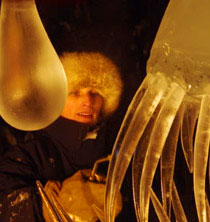

Heather doing a final sharpening and shining of the teeth with a propane torch. Deep sea water fish, “Allure,” for World Ice Art Championships, 2006.
Photo credit: Steve Iverson for
Ice Alaska’s, “Walk in the Park.”
Heather Brown on Process
The conception of a design begins a sketch of an idea or group of ideas. Steve (Brice) and I both use fairly simple line drawings with a clear focus on the negative space of a design. Ice can become invisible if the idea is too complicated and does not have a sharp outline. We scan our sketches, and modify many of them for enlargement into paper templates. Those templates are later glued to the ice with water. However, many aspects of our carvings are done free hand.
Steve Brice is and continues to be my number one mentor, the old masters are particularly inspiring to Steve and myself. In addition, I admire Junichi, and Vladimir Zhikhartsev, both are extremely talented artists.
Ice is temporary. That is why we focus a lot of energy on quality photos, but the short life of the sculpture also has an allure, there is a certain magic knowing that the crystalline pieces will only be around briefly. I take dozens of each piece but the experience is much like an athletic event, a team sport and the memories are magical. Steve and I both do bronze sculpture as well, which gives us a sense of some permanence in our art.
On Gear and Tools
Our cold weather gear includes gloves, not very functional for detail work but necessary at -30 degrees, which it was that night! We normally wear fishermen’s gloves (Oh, so fashionable), orange lined rubber, frequently with seven hour heat packs in them and in my boots and many layers of clothing that we can remove easily when expending more energy. Roughing out with the chainsaw, stacking and leveling are all high-energy activities that keep us too warm. As the pieces come to completion, the detail work comes into play and that is when we tend to get cold. Regulating our activity by shoveling snow to clean up the area is a common occurrence.
The propane torch is used to clear out the ice giving it the crystal look. We use many Makita tools, most modified with a thicker shaft, invented by Steve for safety and specialty bits, which are found through Ice Crafters or on our website. We also use Makita pistol grip sanders, large nail boards (an early Steve invention) for flattening, small nail boards for shaping, and Stihl chainsaws.
Steve has been instrumental in tool development for ice carving. There are very few Ice Sculptors in the world who do not own one of his tools or a tool designed after his. When He began sculpting Ice in 1990, seriously in 1996, there were very few tools on the market specifically for ice. In order for his ideas to take form, he had to create tools that would serve his purpose. These tools play a major role in our achievements in ice. Lake or pond ice, belgium two meter blocks, and Clinebell 300 lb. block ice are the types that I have carved. The ice temperature is the only factor that makes the ice different to carve. When ice is warm it is softer; not as brittle.
On Ice
I’ve not worked with colored ice. The white ice that we feature in the Aurora Ice Museum and that is seen in some of the Ice Art Championship photos is from the overflow and snow layers that occur before the ice is harvested from the ponds, usually it is just a couple inches thick. However, the year that Steve harvested for the initial construction of the Museum, there was an eight inch layer. At first he was dismayed because the clear layer was that much smaller, but then he decided to use it to his advantage. Ultimately the contrast between the two ice types is spectacular. White ice is not quite as dense or as clear because it has many more tiny air bubbles within it. … artists’ bios